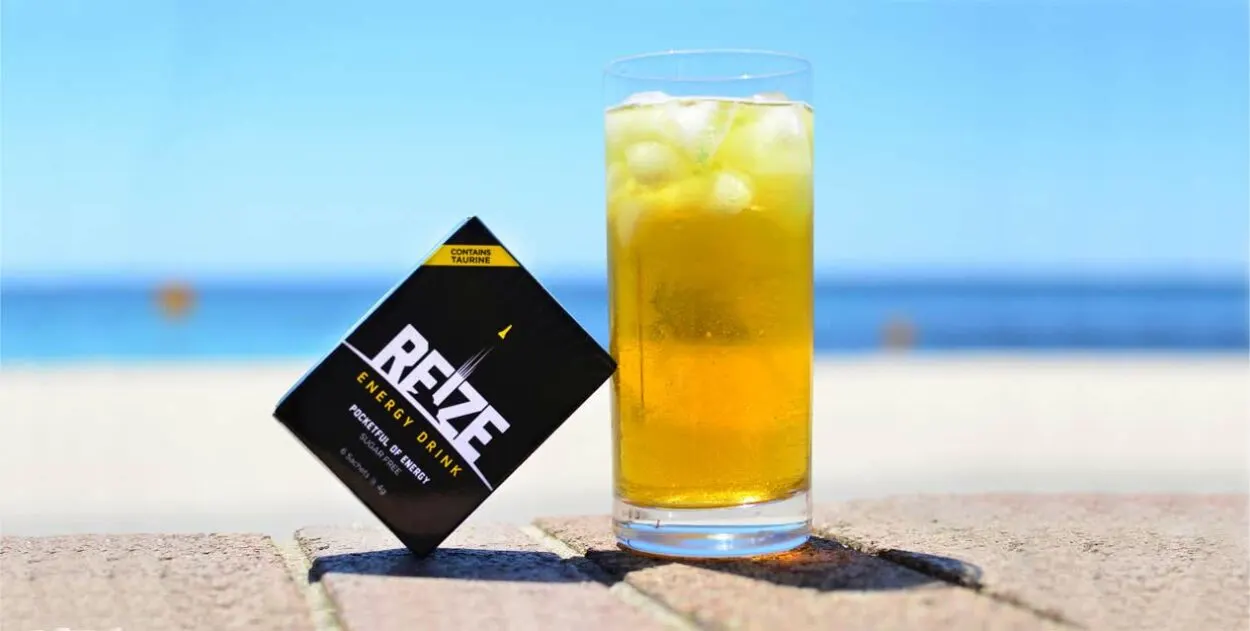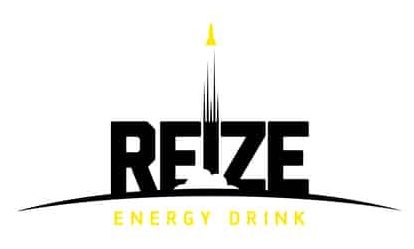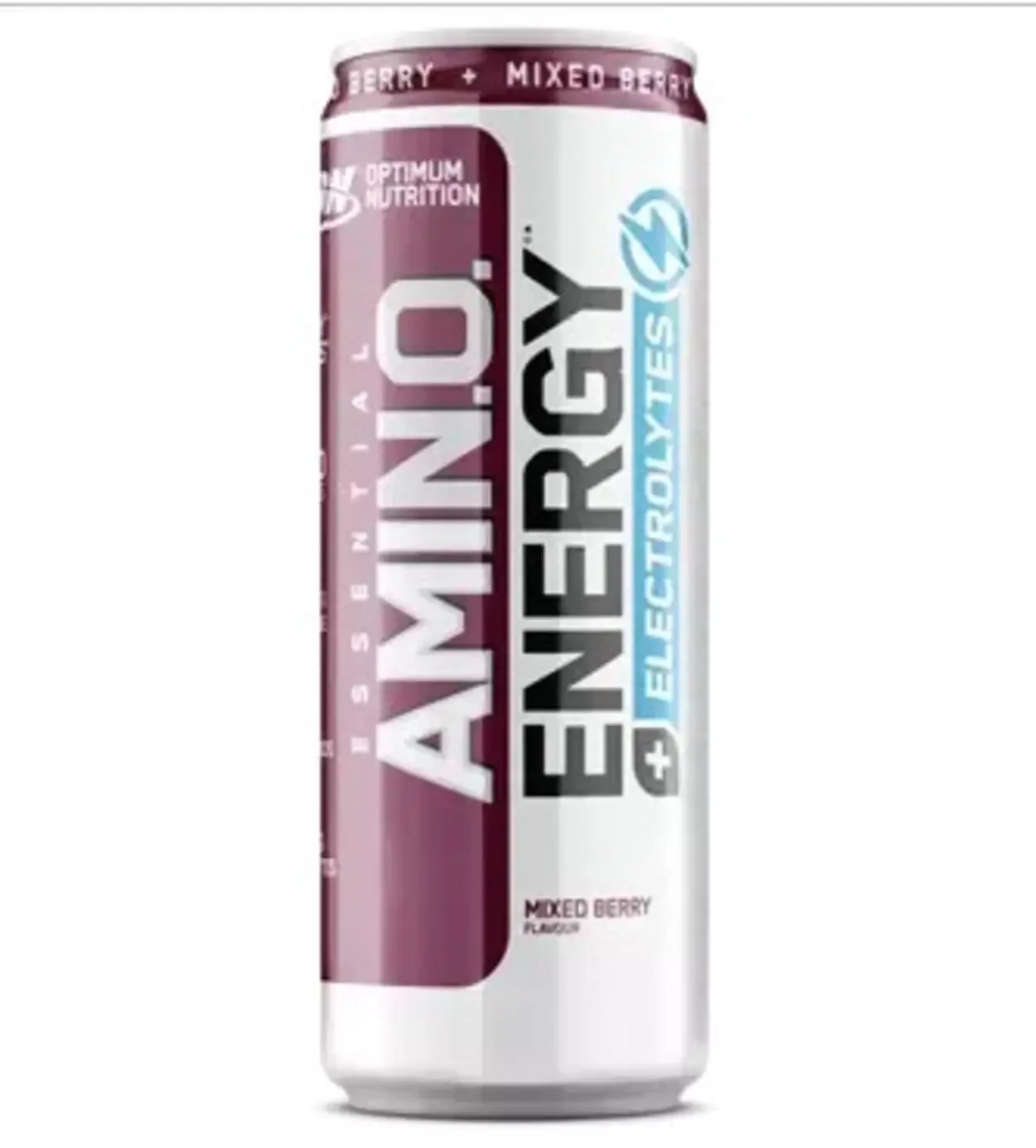Brief Answer: As long as you’re healthy and consuming Amino Energy in moderation, it’s not bad at all.
Essential Amino Energy Plus Electrolytes Sparkling Drink (or more briefly, Amino Energy) is a versatile drink that aims to be an energy booster, recovery drink, and a tasty refreshment all in one.
This nutrition supplement is the brainchild of Optimum Nutrition (ON), a sports nutrition company that manufactures lots of other health and fitness products including protein powders, nutrition bars, multivitamins, and more.
But is Amino Energy drink good or bad for you in reality?
Amino Energy can be good for you since it has minimal caffeine and contains zero sugar, which means that there’s less chance of side effects. Other than that, the drink also contains a proprietary amino acid blend that strengthens the immune system, regulates digestion, and energizes the body.
Let’s get into the details in this post.
What Are The Ingredients In Amino Energy Drink?
A 12 fl. oz can of Amino Energy contains:
- 5 calories
- 100mg caffeine (a decent quantity, in my opinion)
- 5g amino acids (known as the Amino Blend; more details on this below)
- 0g total fat
- 0g saturated fatty acids
- 1g total carbohydrate
- 0g total sugar
- 0g protein
- 100mg salt
It’s also not a significant source of saturated fat, trans fat, cholesterol, dietary fiber, added sugars, vitamin D, calcium, iron, and potassium.
Amino Energy also contains traces of:
- Carbonated Water
- Natural Flavours
- Artificial Flavours
- Citric Acid
- Malic Acid
- Sodium Citrate
- Potassium Sorbate (preservative)
- Potassium Benzoate (preservative)
- Sucralose (artificial sweetener)
- Potassium Chloride
- Magnesium Phosphate
- Tartaric Acid (only in grape and strawberry flavors)
- Acesulfame Potassium (as a sweetener in grape flavor only)
If you’d like to read more about the ingredients in Amino Energy, you can also check out this other post.
What Flavors Are Available For Amino Energy Drink?
Amino Energy is sold in 10 different flavors. There’s more or less something for everyone here:
- Blueberry Lemonade
- Grape
- Juicy Strawberry
- Watermelon
- Green Apple
- Cherry
- Mango Pineapple Limeade
- Peach Bellini
- Ginger Ale
- Mix Berry Sangria
How Much Caffeine Is In A Can Of Amino Energy Drink?
A 12 fl. oz can of Amino Energy drink contains 100mg of naturally occurring caffeine.
When we say “naturally occurring’” here, what we mean is that the caffeine used in Amino Energy was extracted from plants.
Dosage-wise, it’s almost like what you’d expect to get from your average cup of coffee, which usually has around 95mg of caffeine.
With only 100mg of caffeine in a 12 fl. oz drink, Amino Energy stands at the lower end on a scale with regards to its potency as an energy drink.
So what does this mean in terms of how much Amino Energy you can drink every day?
Well, the US Food and Drug Administration (FDA) recommends that you keep to a limit of no more than 400mg of caffeine per day.
That means that you could actually drink up to four cans of Amino Energy in a day, but I wouldn’t recommend drinking that much. You’d still need to take into account the other caffeinated food sources that you’re consuming throughout the day. This includes things like coffee, tea, chocolate, and lots more.
So don’t go overboard with your daily consumption of Amino Energy to avoid excessive caffeine intake. Just stick to a maximum of one to two cans per day.
How Much Caffeine Is Too Much?
Based on the FDA guidelines that I just mentioned, you would be having too much if you consumed more than 400mg of caffeine in a day.
Assuming you’re a healthy adult, taking anything below 400mg of caffeine would be fine.
However, if you have any existing health issues, it’s best that you consult a medical professional for advice before taking any Amino Energy drinks.
It’s important to keep a close watch on your caffeine intake because there are consequences of consuming too much of it. For example, you might experience headaches, insomnia, nervousness, and other negative side effects.
Things can get really bad once you consume more than 10g of caffeine in one sitting, and it may even be fatal. But it’s not that easy to reach those kinds of proportions.
Anyway, the point I’m trying to make here is that you need to know your limits and you should always strive to stay within the safe range of 400mg of caffeine a day. Hence, check out the table below to have a better view of how much the FDA recommends you take your caffeine.
| Age | Recommended Daily Amount |
| Kids | 60-80 mg |
| Teenagers | 100 mg |
| 18 and above | 400 mg |
What is Amino Blend?
Amino Blend is a signature ingredient in Amino Energy drinks. It consists of the following eight amino acids:
- L-Threonine
- L-Leucine
- L-Citrulline
- L-Theanine
- Sustamine L-Alanyl
- L-Glutamine
- Micronized Taurine
- L-Lysine Hydrochloride
Out of these eight ingredients, one of them is a branched-chain amino acid (BCAA) and that is L-Leucine.
BCAAs are essential amino acids that help your body with muscle building. They also cannot be produced by your body itself, so you will need to get them from the food in your diet.
Here are some of the good things that BCAA can do for your body:
- help gain and maintain your muscles
- prevent post-workout muscles soreness
- speed up your recovery from illness or injury
- prevent muscle wastage or breakdown
- treat liver disease
That being said, you’ll need to watch your BCAA dosage closely as taking excessive amounts of it will cause health issues such as nausea, pain, and headaches.
According to some research findings, there’s also a risk of contracting chronic diseases such as these whenever you take too much BCAA:
Please also take note that if you’re pregnant or breastfeeding, you should completely avoid BCAAs.
As far as Amino Energy drinks are concerned, ON didn’t specify the ratio that they used for the amino acids in the Amino Blend. So we don’t really know how much of the BCAA, L-Leucine is in it.
However, since the amount of Amino Blend in each can of Amino Energy only comes out to 5g, I don’t think you’d have to be worried about taking too much BCAA if you’re only drinking one or two cans at a time.
Electrolytes In Amino Energy Drink
Electrolytes are essential minerals in your sweat, urine, and blood that have an electric charge.
Here are some of the key functions of electrolytes:
- regulates nerve and muscle function
- hydrates your body
- balances blood acidity and pressure
- helps rebuild damaged tissues
Sports nutrition company, Optimum Nutrition (ON) included electrolytes as part of the ingredients for Amino Energy drink because they are helpful for your body after you’ve completed any intense physical exercise.
The 100mg of salt that you see listed as part of the ingredients is actually the electrolytes that we’re talking about and includes things like sodium citrate, magnesium phosphate, and potassium chloride.
However, ON has not provided any information about the composition of the electrolytes that have been included in Amino Energy.
If the level of electrolytes in your blood becomes too low or too high, you’ll face the problem of an electrolyte imbalance. If this condition becomes too severe, you may end up experiencing symptoms like:
- fatigue
- irregular heartbeat
- numbness and tingling
- confusion
- muscle weakness and cramping
- headaches
- convulsions
In extreme cases, this could turn into something that’s life-threatening too.
This is why it’s crucial to stay hydrated at all times, and that’s ON’s motivation for creating a drink like Amino Energy which will certainly come in handy for you whenever you need to rejuvenate yourself.
But of course, you always need to exercise moderation in terms of how much Amino Energy you drink as well. After all, drinking excessive amounts might also end up contributing to an electrolyte imbalance issue in your body.
What Sweeteners Are Used In Amino Energy?
Amino Energy doesn’t contain any sugar, so sucralose is used to flavor the drink instead.
Sucralose is one of the popular artificial sweeteners that is being used in many of the processed food and drinks that we frequently enjoy. For example, you’ll find it in diet sodas, chewing gum, products containing gelatin, and even frozen desserts
The great thing about using sugar substitutes like sucralose is that it makes the food that it flavors calorie-free. Sucralose in particular has the added advantage of not leaving a bitter aftertaste in your mouth.
You’ll find sucralose on the ingredients list for all Amino Energy drink flavors.
However, for the grape-flavored Amino Energy drink, you’ll see two sweeteners listed there instead of just one:
Sucralose and acesulfame potassium or acesulfame K (Ace-K for short).
Ace-K functions in pretty much the same way that sucralose does. In fact, it’s said to be 200 times sweeter than sugar.
Although sucralose and Ace-K do help us avoid the problems associated with sugar consumption, their presence in Amino Energy drinks may bring about a different set of health risks.
Is It Safe To Consume Sucralose?
Yes, it is safe to consume sucralose.
Sucralose has been approved by the U.S. Food and Drug Administration (FDA) and many other health agencies around the world.
Nevertheless, you should still consume it moderately as some research has linked sucralose to certain health issues, claiming that it is metabolized in the digestive tract. Of course, if this is actually the case, then it wouldn’t be very good for your gut health, insulin levels, and weight.
Right now, there’s still a lack of evidence to prove whether sucralose is bad for you or otherwise. So, to be on the safe side, I wouldn’t recommend that you have too much of anything that has sucralose in it, like Amino Energy.
If my explanation still leaves you in doubt or if you’re worried about how sucralose might affect you, it might be better for you to speak to your own doctor about what’s best for you.
Is Amino Energy A Good Energy Booster?
Yes, I personally think that Amino Energy is a good yet mild energy booster.
I say this because I find it to be not as strong in its impact compared to other energy drinks.
I figure that this might be because it’s missing some of the additional stimulants you’d often find in other drinks. I’m talking about ingredients like ginseng, guarana extract, taurine, and B Vitamins.
Usually, ingredients such as these will help to further enhance the effects of caffeine in an energy drink.
But for Amino Energy, the only ingredient that I could find that might have some impact was the micronized taurine in its Amino Blend. But the amount doesn’t seem significant enough for it to have much of an energy-boosting effect.
Well, if you’re content with having just a mild caffeine boost, then Amino Energy may still be able to provide you with what you need. But then again, you’d probably need to try it for yourself to know for sure.
The good thing about Amino Energy though is that it’s sugarless. So at the very least, you’ll have one less worry on your mind when you drink it.
Given that the caffeine content in Amino Energy is only 100mg per 12 fl. oz can, I’d say there’s a decent bit of caffeine in there to help give you the perk you need as and when you want it.
Is It Safe To Drink Amino Energy Drink Every Day?
If you ask me, I think it’s safe to drink Amino Energy drink every day if you’re a healthy adult.
The effect is almost the same as drinking a cup of coffee daily as the caffeine content in both beverages is about the same.
It’s definitely not recommended for you if you have any ongoing health conditions. You won’t want it to interfere with your medication or worsen your condition in any way, so please consult a doctor before drinking any Amino Energy.
If you do go ahead with drinking Amino Energy every day, please remember to keep track of how many Amino Energy cans you are drinking each day in order to prevent yourself from unknowingly consuming too much over time.
Are There Any Side Effects From Drinking Amino Energy?
Here are some side effects that you might encounter if you have one too many energy drinks:
- caffeine overdose
- type 2 diabetes
- adverse neurological effects (in adolescents and children)
- obesity
Since Amino Energy is a sugar-free drink, it’s very unlikely that Type 2 diabetes or obesity will become a problem for you here.
However, there are limits to how many artificial sweeteners you should have every day.
For sucralose, which is used in all Amino Energy flavors, you should limit yourself to consuming only 9 mg/kg body weight per day. So, for example, if you weigh 50kg (110 pounds), you can only have a maximum of 450mg of sucralose in a day.
As for ace-K, which you’ll find being used alongside sucralose for the grape-flavored Amino Energy drink, you should only take 15 mg/kg body weight of it within a day.
If you were to exceed the Acceptable Daily Intake (ADI) amounts for sucralose and/or Ace-K as given above, you might end up facing these kinds of side effects:
- headaches
- diarrhea
- respiratory problems
- dizziness
- nausea
- digestive problems
- bloating
- allergies
- mood swings
As for caffeine overdose, this would only truly become an issue if you had a lot of cans of Amino Energy. There is only 100mg of caffeine in a 12 fl. oz can, so if you control your intake and take a maximum of one to two a day, it shouldn’t be a problem.
However, in the event that you did consume too many cans of Amino Energy, these are the potential side effects you may encounter from having too much caffeine:
- anxiety
- insomnia
- digestive issues
- muscle breakdown
- addiction
- high blood pressure
- fatigue
Despite this rather alarming list of side effects, you should be able to avoid them if you drink only small quantities of Amino Energy at a time. So I would advise that you stick to drinking only one or two cans each day.
Is Amino Energy Drink Bad For You?
I personally don’t think that Amino Energy drinks are bad for you as long as you drink them in moderation.
One serving of Amino Energy only contains 100mg of caffeine, which is only about one-quarter of the 400mg maximum daily intake that’s recommended by the FDA.
Amino Energy is sugar-free so it isn’t bad for you in the sense that you won’t face sugar crashes or have to deal with cavities in your teeth.
However, the artificial sweeteners used in Amino Energy, sucralose, and ace-K, may become a health hazard if you consume too much of them. So just make sure to stay within the daily ADI of 9 mg/kg of your body weight for sucralose and 15 mg/kg body weight for Ace-K and you should be fine.
Meanwhile, Amino Energy is only very lightly carbonated and flavored, so I doubt that it’s acidic enough to become a health concern for you.
Where Can I Buy Amino Energy And How Much Is It?
Amino Energy is widely distributed in the US so you can easily purchase it at most drug stores, supermarkets, fitness centers, gyms, and grocery stores throughout the country.
Even if you live elsewhere, rest assured that it won’t be hard to locate Amino Energy as it’s distributed across more than 70 countries worldwide.
There’s also the option of ordering it online too. However, you may need to factor in shipping costs if you choose to go this route.
Expect a 12 fl. oz can of Amino Energy to cost you around $2 each.
Alternatives to Amino Energy Drink
There are plenty of alternatives to Amino Energy drinks out there, so if you’re keen on trying them out, check out this list of ready-to-drink options:
- Monster
- Red Bull
- Celsius
- Rockstar
- XS
- Monster Import (not the same as your regular Monster)
- Rip It
- Bing
- Guru
- Xyience
You can also look up Mio water drops if you prefer that as your caffeine supplement instead.
You may also want to consider powdered energy drinks because they are more convenient to carry around and much more affordable than your conventional energy drink options.
If it interests you, then you might want to check out the following brands:
- Gfuel
- Zipfizz
- Advocare Spark
- REIZE (I highly recommend this one)
REIZE (10 out of 10)

It’s really easy to make yourself a glass of REIZE energy drink. Simply mix the powder from your 4g sachet into any of your favorite beverages.
REIZE makes a great daily health supplement, thanks to its combination of energy-boosting ingredients: taurine, B Vitamins, ginseng, and more.
With just 50mg of caffeine in each sachet, you’ll be getting just the right amount to enhance your physical and mental performance, but not enough to cause any nasty side effects.
REIZE is sugar-free too and has only 11 calories per serving so it’s no threat to any weight management program you might be on.
The best part of it all is that REIZE is delivered right to your doorstep at only around $1 per sachet, and this includes shipping costs. Amazing value for money!
Give REIZE a shot today and see for yourself what a positive difference it can make to your daily routine.

